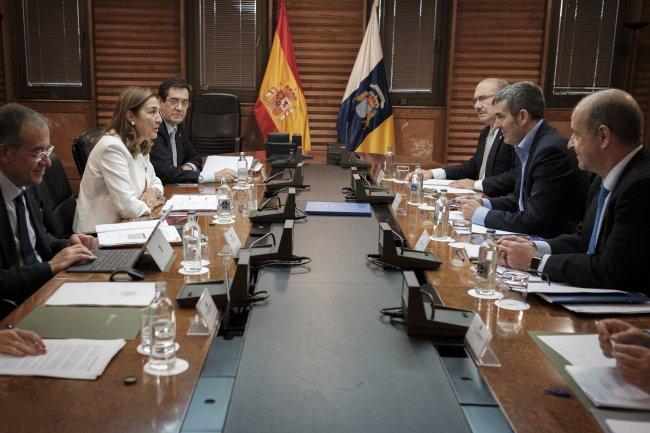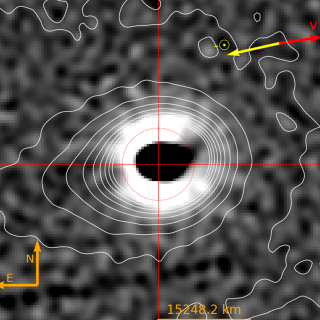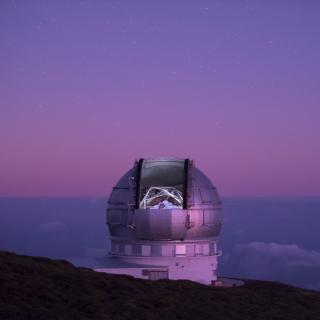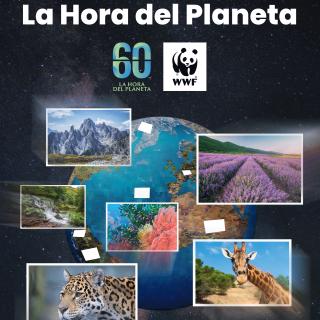The President of the Government of the Canaries, Fernando Clavijo, presided yesterday, 7th July, a meeting of the Board of Directors of the Instituto de Astrofísica de Canarias (IAC) at which the Secretary of State for Research, Development and Innovation of the Ministry of Economy and Competitivity, Carmen Vela Olmo, the Councillor of Economy, Industry, Commerce and Knowledge of the Canary Government, Pedro Ortega, the Rector of the University of La Laguna, Antonio Martinón, and Rafael Rebolo, Director of the Instituto de Astrofísica de Canarias were also present. The meeting took place at the Headquarters of the Presidency of the Government of the Canaries in Las Palmas.
The members of the Board of Management, at the end of the meeting, stressed the scientific excellence which the IAC has maintained, as shown by the renewal of its award as a Severo Ochoa Centre. At the meeting the handling of the 2015 budget was approved, and funds were assigned for 2017. The financial grant to the IAC foreseen for next year are 4,5 million euros from the Canary Government, and 11 million euros from the Spanish government. The IAC obtains some 8 million euros per year in additional funding from national and international competitions.
“The Canaries” said Fernando Clavijo “will have invested over 20 million euros in the period 2014-2020 for one of the world renowned reference points among the major scientific-technical installations on the national map: The Gran Telescopio CANARIAS (GTC). We must keep working to bring in new international investors in the astronomical field, to contribute to the leadership of the Canaries in this sector to keep us as an international reference and to continue to broaden the attraction of this scientific installation for the research teams in future years”.
The Director of the IAC, Rafael Rebolo, commented on the budget for 2017 which shows that the two administrations are doing everything possible to put into practice the four year plan approved for the years 2014-2017 and that “would allow us to reach budget levels comparable to those we had 10 years ago”. He added that “This is positive because it will help us to maintain our activity in very important projects”.
The Secretary of State, Carmen Vela emphasized about the future of the IAC that “There will never be a lack of projects”, and picked out some of them, such as that signed with the University of Tokyo in Japan for the installation of 4 Cherenkov telescopes, a project which is now under way, and the Large European Solar Telescope (EST) and she noted the possibility that the 30 m Telescope (TMT) originally to be installed in Hawaii could be installed in the Canaries”. To successfully bring this extraordinary telescope here would imply attracting very big funding, and also something very important, it would mean that the University of California in the USA would look at the Canary Islands and see them as a major power in Astrophyiscs with enormous capacity for the future”. Rebolo informed the Board than “The International TMT Consortium in which countries such as Chin, Japan, Canada and India are participating, as well as the United States, could decide its final site in April of next year”.
Large Telescopes
The IAC is continiuing to work with the international consortia which aim to develop large telescopic installations, some of them of strategic European interest, and have expressed an interest to place them in the Canary Observatories. The Director of the IAC gave a report on progress in the negotiations on the Liverpool 2 Telescope (LT2), of 4m diameter, the first robotic telescope of this size.
As for the headquarters of the Cherenkov Telescope Array (CTA) in the Northern Hemisphere the Board of Management was informed about the negotiations for the signing of the agreement for its installation at the Roque de los Muchachos Observatory (La Palma) the site which was chosen in July 2015.
Rebolo also reported that the European Solar Telescope (EST) the largest solar telescope in the world, had finally been included in the route map of the European Strategy Forum on Research Infrastructures (ESFRI) as a project led by Spain and coordinated by the IAC, which would be fundamental for solar physics in the XXI century.
He also reported that the members of the Technical Commission of the Thirty Meter Telescope (TMT), led by the University of California and Caltech, in the United States, had studied the conditions and the potential of the Roque de los Muchachos Observatory (La Palma) as a possible alternative site for this telescope, if it were finally turned down by Hawaii. Those specialists confirmed that the conditions offered by the Canaries are very good for the building and installation of this telescope, and with an operational budget significantly lower than that demanded by Hawaii. The Board of Directors showed unanimous support for the IAC so that La Palma could finally be the site for this powerful installation.



